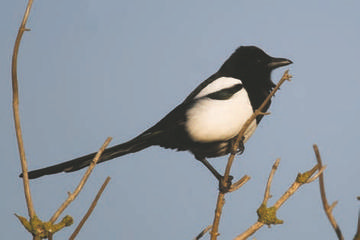
Magpie © Simon Booth
The distribution map shows that, bar a few odd spots of under-recording, Magpies are ubiquitous in winter. Compared to the breeding season, birds move to fill in the gaps in the Cheshire hills, although not onto Hilbre Island. This is one of the most sedentary of all species, with the median distance of movement of ringed birds less than 1 km, although the daily roamings of non-territorial birds, and the distance they go to roost, are likely to exceed that. There has been no proof of any immigration from the continent to Britain (Migration Atlas).
The habitat records show a minor shift onto farmland (53% of winter records, against 44% of breeding records) and commensurate small losses from woodland, scrub and human sites. Within farmland, more birds than in the breeding season were using improved grassland and hedges, and fewer were found on arable land. Magpies were much less likely to be found on stubble than Carrion Crow, Jackdaw or Rook. They eat mostly vegetable material during winter – nuts, seeds, grain – and often store food, although usually for only a day or two (BTO Winter Atlas). These intelligent and opportunistic birds will steal from other species, including robbing Jays’ cached food, and can be found trying almost anything edible.
Observers submitted 610 counts of Magpies, half of them of four birds or fewer, but there were eight counts of 30 or more, going way beyond the ‘one for sorrow, two for joy, …’ rhyme, with the largest flock 80 birds at Fiddler’s Ferry (SJ58M). Roosts were noted in 13 tetrads, with a typical size of 50 birds, but by far the largest at Woolston (SJ68P), where Brian Martin counted a minimum of 111 birds on 22 January 2006 entering willows and elders.
By the end of our winter period, many Magpies were showing breeding intent, often starting to build nests in February.
Sponsored by Fran Cogger

